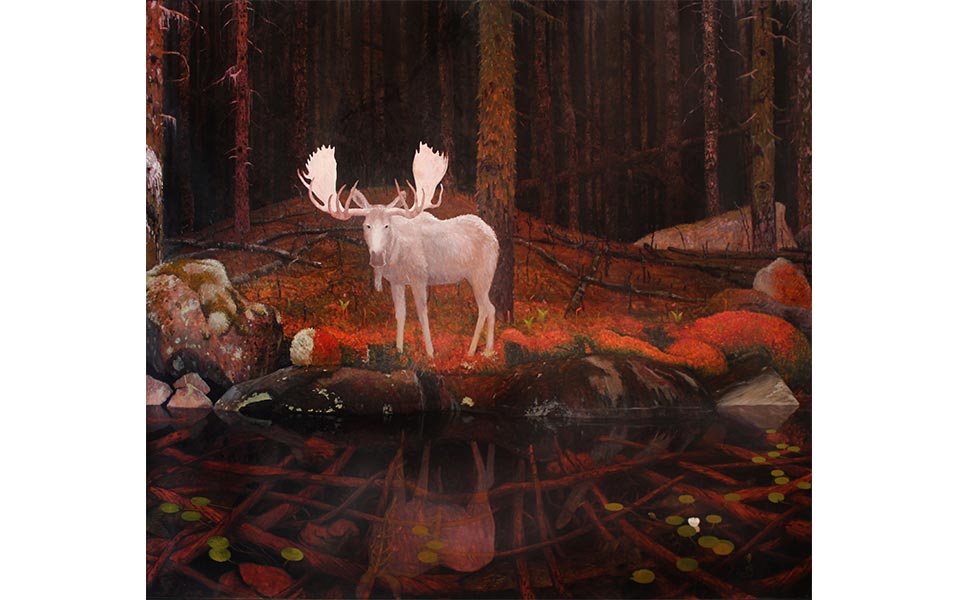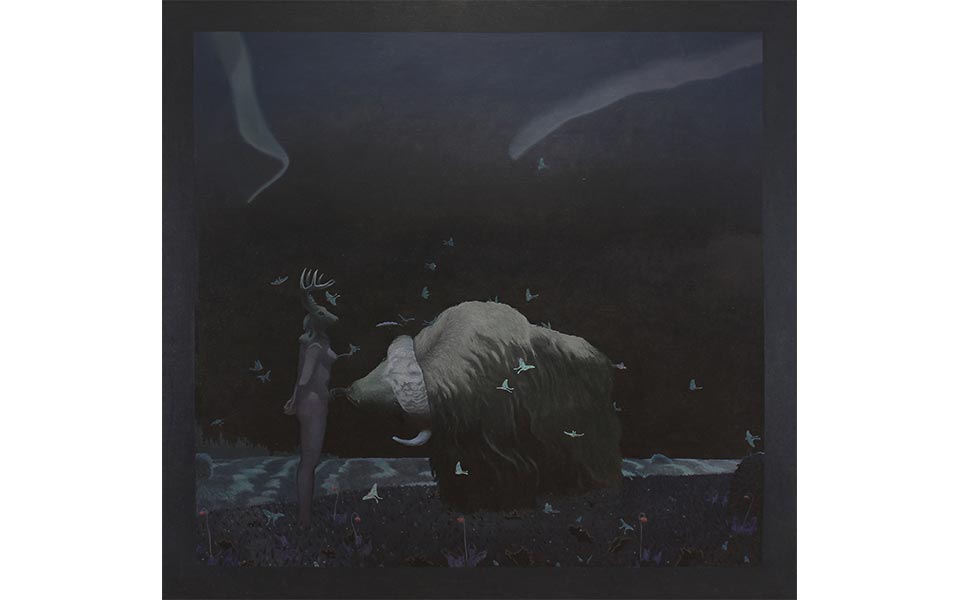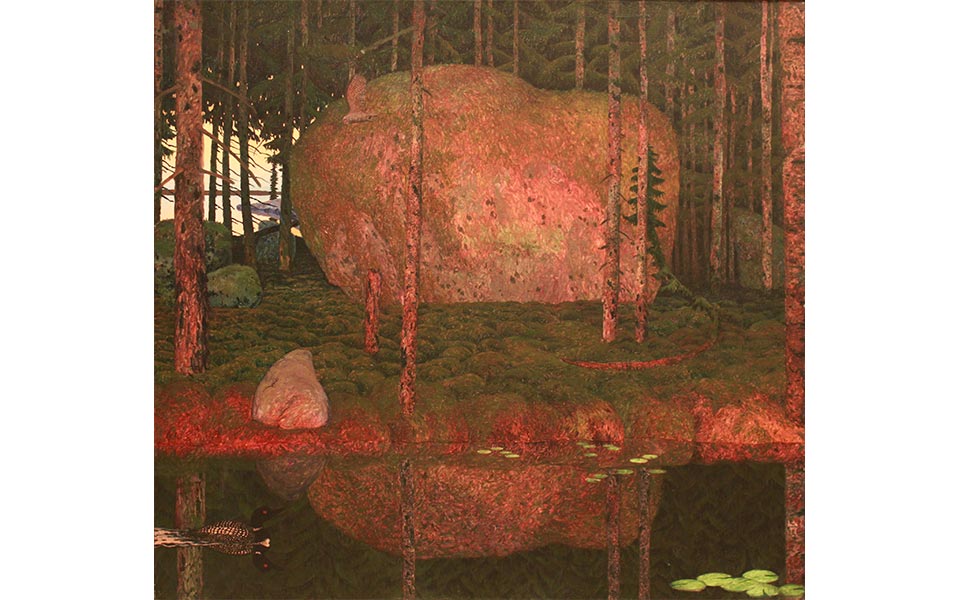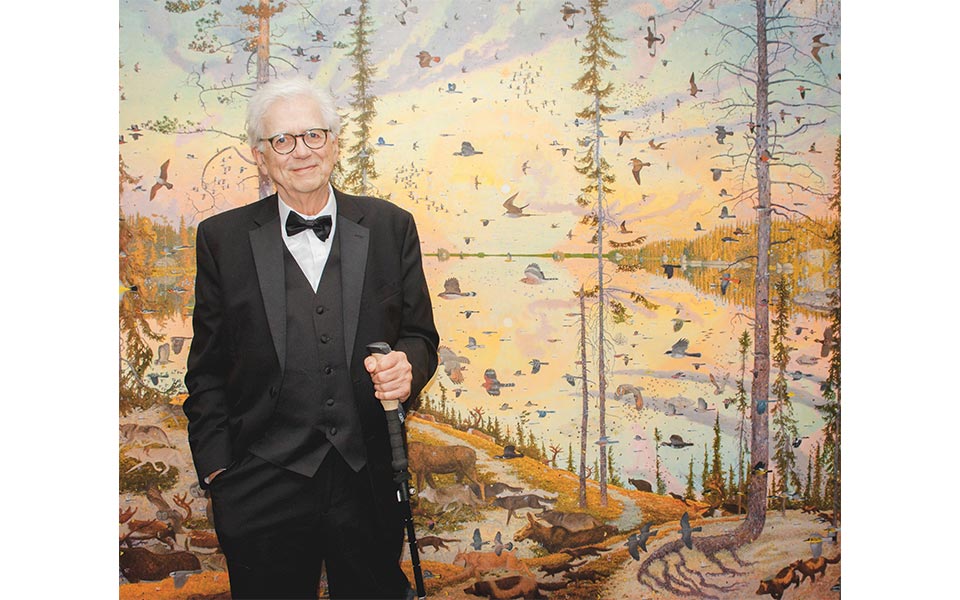Tom Uttech – Into The Woods
On View: October 12, 2019 –January 12, 2020
Museum of Wisconsin Art Wisconsin native Tom Uttech is recognized as one of the leading landscape painters working today in the United States. Often categorized as a Magic Realist, his paintings weave together a mystical world of both imagined and real elements. Uttech’s paintings are easily identifiable by their complex devotion to nature, one that is equally raw and wild and familiar and inviting. His inspiration derives from decades of travel to Northern Minnesota and the Quetico Provincial Park in Ontario, Canada. Uttech’s world is one of waterways, shorelines, and tumbling rocks precariously perched within thickets of growth.
Over the last decade, Uttech’s enchanted forests have become home and stage to animal migration, a natural phenomenon rooted in eons of animal behavior and evolution. Part fantasy, part natural science, these migration paintings are compelling not only for their settings but for the hundreds of species of animals flying, swarming, and bolting across his paintings on a timeless mission and in a perpetual state of reenactment. Uttech does not identify as an environmental artist, but his treatment of the migration subject has become synonymous with encroaching dangers that finds resonance in contemporary issues of wildlife preservation. Uttech is in many ways most comfortable in the north woods or the forests that surround his forty-acre farm in Saukville, Wisconsin, which is also home to his converted barn-studio.
Into the Woods is the artist’s first full-career retrospective that will include never-before-seen early paintings and drawings as well as a number of his large-scale migration series paintings from the last decade. In anticipation of the exhibition, MOWA commissioned Nin Gassinsibingwe, the most recent and in many ways most spectacular painting in his ongoing migration series. The Ojibwe title translates as: “I Wipe My Tears.” The exhibition is accompanied by a major gift of almost two hundred photographs that was made possible by the artist and the Kohler Foundation, Inc. The exhibition is curatedby Executive Director Laurie Winters.
One of the most widely admired landscape painters working in America today, Tom Uttech weaves a mystical world of imagined and real elements that are loosely based on his beloved North Woods. Into the Woods is Uttech’s first full-career retrospective and a celebration of his recent gift to the Museum of Wisconsin Art (MOWA) of almost two hundred photographs. For the first time in MOWA’s history, all three changing exhibition spaces and much of the permanentcollection area have been dedicated to the work of a single artist.
Uttech’s sixty-year career is characterized by four distinct phases of development. The story begins at MOWA in the State Gallery with a series of early paintings, drawings, and photographs that chartthe course of his career. The bulk of his photography—all dating from a relatively short but intense period from 1970 to 1982—is displayed upstairs in the Hyde and Horicon Bank galleries. Iconic mature landscapes, dating after 1983, and his more recent migrationpaintings are on view in the Modern and Contemporary galleries,respectively. A single monumental work from 1987 is located in the West Bend Mutual Insurance Atrium. Visitors may experience the four sections chronologically or take a random walk through the museum and simply immerse themselves in the work at hand.
Engagement beckons everywhere in Uttech’s enchanted forests—no particular pathway is required.
THE FOREST AS A PLACE OF MAGIC AND DANGER
Tom Uttech was born in 1942. He grew up outside of Wausau, a lumber and mining town in a remote, densely forested area of Wisconsin. Uttech’s grandparents were farmers and cheesemakers, who had emigrated from Germany, and by all accounts life was a harsh, knuckle-to-the-bone existence. His parents’ wood-frame home stood where country roads pass by small farms and gradually give way to forests of pine and spruce that extend for hundreds of miles in every direction. It was on the edge of these two worlds—between city and forest—that Uttech found his childhood playground. As if drawn from the pages of Grimm’s Fairy Tales, the forest seemed to be a place of enchantment and transformation where danger and adventure awaited in equal proportion.
In the early 1960s, as a student at the Layton School of Art in Milwaukee, Uttech discovered the surrealist works of Wisconsin painter John Wilde (1919–2006) and the music of Finnish composer Jean Sibelius (1865–1957). Their dreamlike imagery and evocations of nature encouraged Uttech to pursue his own personal and emotive response. In A Painting for Jean Sibelius (1965), a rare, early work, Uttech drew inspiration from the forest spirits of Finnish folklore and mythology featured in the composer’s music. In the painting, the spirit Tapio and a great gray owl guide a woodsman through the metaphor-rich gloom of nightfall. Uttech had found a kindred Nordic spirit in Sibelius and a visual grammar for the feelings and experiences he had encountered in childhood.
THE ANCIENT CORE OF BEING
The year 1968 was pivotal for Uttech. He became a professor of art at the University of Wisconsin–Milwaukee and made his first of many trips to Quetico Provincial Park in Canada. The park lies within several million acres of protected wilderness known as the Boundary Waters, which straddles the Canada-United States border between Ontario and Minnesota. Geologically, the region exists on Precambrian bedrock— the ancient core of the North American continent—covered with a thin layer of soil that supports vast forests of pines, spruces, and larches. These forests, as well as the area’s intricate labyrinths of glacial lakesand streams, are home to a rich variety of flora and fauna.
Inspired by the undisturbed, primeval character of the Boundary Waters, Uttech swiftly developed a formal vocabulary based on the idea of a spiritually animated nature. In Painting for Buckingham Lake, he alluded to the area’s cosmic origins through a hovering half human female/ half bull moose apparition rising above the lake’s placid waters. Its enormous antlers reference and invert the shapes of the smooth glaciated granite shorelines where the southern rim of the Precambrian Shield is fully exposed. The Quetico offered Uttech a place where nature’s primordial rhythms still existed.
EVERYTHING—ALL AT ONCE
The mid-1970s was a period of questioning and uncertainty. Uttech was teaching but he felt out of sync with conceptual, minimalist, and psychedelic trends in the contemporary art world. In a moment of frustration, he decided to put everything that had ever interested him into a single painting. It was “everything—all at once.” From this one work emerged the building blocks of subject and composition he would return to throughout his career.
Inspired by his annual pilgrimages to the Boundary Waters, Uttechcreated a fantastic, fictional world. Set on a high precipice with aplunging vista, a mythic deer emerges from a pitcher plant and isflanked by a birch bark male figure that recalls earlier forest spirits. Storm clouds, brilliant sunbeams, and a rainbow coexist in a vast sky while birch trees with wide-open eyes look back as if to suggest that nature is not only alive but inhabited by spiritual essences. Uttech had struggled to see his way forward, and now this fantastic world was looking back as if to welcome him, a seer, into the spectacle of nature.
Marcia Tucker, then curator of painting and sculpture at the Whitney Museum of American Art, spotted this painting in an off-the-beaten- track gallery exhibition in Cincinnati, and included it in the much- coveted 1975 Whitney Biennial. The exhibition brought Uttech significant national recognition and catalyzed a burgeoning career.
MYTH AS A WAY OF SEEING
Common to most Nordic and cultures in densely wooded regions is the animistic belief that spiritual essences inhabit and animate distinct places and creatures of the forest. This worldview resonated with Uttech and was reinforced by an older Anishinaabe man he had met and become friendly with on trips to the Boundary Waters. Their conversations fostered new ways of seeing and expressing the spiritual in Uttech’s work.
In a Mid-Summer Night’s Dream, Uttech imagined a surreal encounter between a half female/ half deer creature and a musk ox, a woolly breed native to the arctic tundra. Fluttering night moths surround the ghostly white silhouettes and reinforce their tenuous connection to the physical world. Fascinated by the motif of a deer head, Uttech used it again in a number of large finished charcoal drawings in which thecreatures act as guardians of the forest and a vast array of animals. The drawings are also remarkable for the growing population of eyes that blanket nearly every surface of the forest setting and create the impression of an alert and active nature.
In one such drawing, a single deer-creature directly engages the viewer while holding aloft a moose skull emblazoned with a single all-seeing eye. Embedded within the image is the idea of an animate, seeing nature, along with the idea of the mirrored eye of the artist. The monumental eye powerfully suggests an increasing ambiguity between seeing and being seen, or, put another way, Uttech here seems to place himself in and at the very center of this dreamlike realm.






